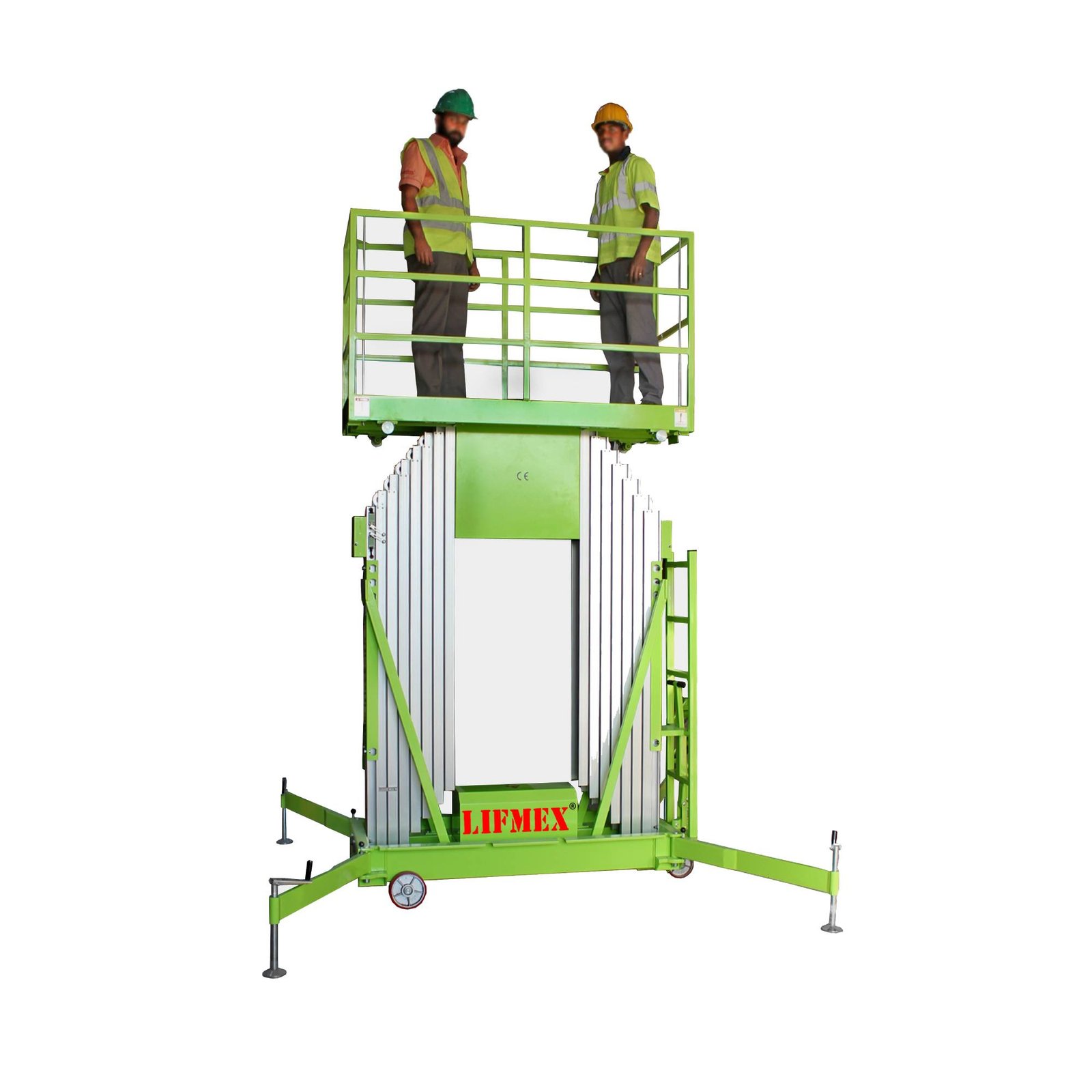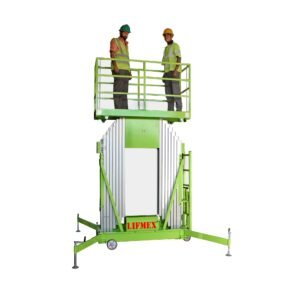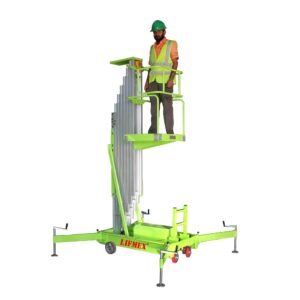What is a Scissor Lift?
Scissor lifts are a type of manlift that is commonly used in construction and facility maintenance to raise employees and their tools to working heights.
The scissor lift integrates a power system and a control system, working in tandem to achieve efficient elevation. This symbiotic relationship involves the control system, powered by electricity, diesel, or compressed air, operating on the same principle. The process entails driving the pressure pump to increase hydraulic pressure in the cylinder, pumping hydraulic oil into the sleeve cylinder, and supporting the lift arms to achieve elevation using 220V or 380V phase change electricity.
Functioning as a mechanical apparatus, the scissor lift utilizes electric energy to facilitate the lifting or lowering of objects. Primarily deployed in high-altitude tasks across various industries such as enterprises, chemical, municipal administration, electric power, and transportation, it serves as a crucial tool in enhancing productivity and safety in elevated work environments.
Types of Scissor Lifts
Scissor lifts exhibit structural diversity, categorized into four main types: scissor cylinder type, aluminum alloy (column) type, crank type, and chain type. Each variant is designed for specific applications, offering distinct advantages in terms of maneuverability, ease of use, and lifting capabilities. These versatile lifts are well-suited for a broad spectrum of home-related tasks, providing reliable functionality and robust balance across various work scenarios.
The different types of scissor lifts include:
Electric Scissor Lift
“Electric scissor lifts stand out as eco-friendly alternatives, powered by batteries rather than combustion engines. Their operation produces no exhaust emissions or loud noises, making them ideal for interior use. Compared to diesel scissor lifts, electric counterparts are often more compact, with narrower platforms, making them well-suited for indoor applications. To safeguard floors during operations, non-marking tires are commonly employed. While electric scissor lifts may have smaller platforms and lower load-bearing capacities than their fossil fuel-powered counterparts (diesel, gas, or propane), their portability is a key advantage. These smaller lifts can be easily transported between job locations, either towed or mounted on various vehicles such as automated guided vehicles (AGVs), flatbeds, or railcars for specialized applications. The all-steel construction and twin shear scissor stack ensure rigidity and durability, contributing to a long operating life. With high-quality components, electric scissor lifts operate reliably and consistently, and their deep cycle batteries provide longevity throughout extended job durations.”
Hydraulic Scissor Lifts
Hydraulic scissor lifts offer versatile applications both indoors and outdoors, powered by either an electric motor or compressed air. The hydraulic system facilitates the lifting and lowering of the scissor lift by pushing or draining hydraulic fluid between cylinders. This mechanism allows hydraulic scissor lifts to find utility in diverse settings such as warehouses, construction sites, and infrastructure projects.
To operate a hydraulic scissor lift, the operator initiates the power supply, and a valve controls the flow of hydraulic fluid or compressed air. The fluid is then transferred from the reservoir to the operating cylinders through the scissor lift control system. For upward movement, the hydraulic cylinder extends, causing the scissor legs to spread apart and elevate the platform. To lower the scissor lift, the operator releases hydraulic fluid or decreases pneumatic pressure, allowing the scissor legs to retract.
The term “scissor” originates from the cross-braced mechanism resembling the arms of a pair of scissors between the base and the higher platform. Fixed installation lifts are commonly employed to transport goods from vehicles to a building’s goods receiving rooms across different floor levels. Additionally, mobile hydraulic scissor lifts, characterized by their compact and lightweight design, serve the purpose of moving cargo or large objects within a factory or workshop.
Diesel Powered Scissor Lift
Diesel scissor lifts are conventionally powered by traditional diesel engines. Unlike their electric counterparts, these lifts are less environmentally friendly, emitting noise and polluting exhaust fumes during operation. With larger platforms, diesel scissor lifts excel in outdoor construction projects and well-ventilated indoor spaces where engine noise won’t disrupt crucial communication among workers. Despite being less eco-friendly, diesel proves to be a cost-effective fuel option, delivering substantial torque at low RPM levels.
Heavy-duty variants of scissor lifts are prevalent, featuring larger platforms and enhanced load capacities. Certain models incorporate a hybrid powertrain, catering to the needs of closed job sites. Diesel scissor lifts stand out as some of the most powerful options, well-suited for demanding tasks. Particularly favored for outdoor assignments, robust versions, including those designed for tough terrain, excel on uneven ground. With expansive deck surfaces and high platform capacities, these diesel scissor lifts empower operators to efficiently manage bulky and heavy equipment.
Rough Terrain Scissor Lift
Rough terrain scissor lifts, classified as Elevated Work Platforms (EWPs), are specifically designed for robust outdoor applications, providing enhanced power to navigate challenging conditions. Fueled by combustion engines such as diesel, petrol, or LPG, they deliver the necessary strength to operate in harsh environments and lift substantial loads. These lifts boast increased traction and travel speed, facilitating safe maneuverability across expansive construction sites. Primarily tasked with elevating individuals and objects from uneven ground, they excel in challenging environments, enhancing productivity through positive traction, gradeability, and speed.
Rough terrain scissor lifts are equipped with gradeability as a crucial metric. Distinct from the operating angle, which represents the steepest gradient a machine can function on, gradeability specifically denotes the steepest slope a machine can ascend. In the accessibility industry, gradeability characterizes the incline a machine can successfully climb up or descend. These rough terrain lifts feature high-performance tires and 4WD capabilities, ensuring they have the necessary power to navigate steeper slopes effectively.
Types of Scissor Lifts available
Aerial Double Mast
GET IT NOW
Aerial Single Mast
GET IT NOW
Applications and Benefits of Scissor Lifts
Building Maintenance
- Changing lights, hanging banners, laying bricks, pouring concrete, changing signs, and accessing utilities are common tasks that require working at elevated heights.
- Scissor lifts are a preferred choice for inside structures, ensuring safe completion of duties, and their portability allows them to be moved easily between different areas within buildings.
- Frequently utilized in places like churches, libraries, schools, and hospitals for maintenance applications.
Building Construction
- Scissor lifts offer a portable and adaptable solution for construction projects with dynamic conditions.
- Ideal for contracting work, including renovations and various construction tasks.
Delivery Operations
- Scissor lifts excel in activities involving reaching great heights and handling large cargo that is challenging to lift manually.
- Commonly used in busy shipping hubs to enhance efficiency.
Signage Installation and Maintenance
- Perfect for businesses that frequently change signage, such as mechanic workshops, storage facilities, and parking lots.
- Scissor lifts, whether rented or purchased, provide a solution to the challenges associated with signage changes.
Production Efficiency
- Aerial platforms, like scissor lifts, contribute to improved operating efficiencies by swiftly and safely reaching great heights and lifting heavy items.
- Beneficial in manufacturing, chemical transformations, food processing, and brick-laying.
Warehousing and Storage
- Essential for maximizing both vertical and horizontal space in warehouses, ensuring efficient utilization of available space.
- Investing in scissor lifts for warehouses can expedite storage and retrieval processes.
Real Estate Management, Landscaping, and Transportation
- Scissor lifts find applications in real estate management, landscaping, and transportation management, contributing to efficient operations and improved productivity in these sectors.
The advantages of scissor lifts include:
Productivity Improvement
- Scissor lifts enhance efficiency in palletizing and loading tasks, reducing cycle times and increasing loading efficiency.
- Setting the work surface at the correct height contributes to streamlined operations.
Workplace Injury Reduction
- Minimizes the risk of back injuries associated with heavy lifting, especially during tasks like offloading heavy goods.
- Lift tables, such as scissor lifts, alleviate strain by positioning pallets at a comfortable height, reducing both vertical and horizontal lifting stress.
Process Ergonomics Enhancement
- Easily adjustable scissor lifts allow each operator to work at a preferred height, optimizing stacking and loading tasks.
- Improves ergonomic conditions by reducing the need for bending and twisting to adapt to table height.
Access to High and Difficult-to-Reach Areas
- Provides access to elevated areas, reaching heights up to 32 feet, enabling employees to reach challenging locations.
- The lifting capacity and height are proportional to the overall weight of the lift, making it versatile for various tasks.
User-Friendly Operation
- Simple controls reduce operator fatigue and enable quick learning, ensuring efficient utilization of the technology.
Compact Dimensions
- Among the smallest aerial work platforms, scissor lifts are ideal for confined spaces like event rooms and tightly packed warehouses.
Floor Area Efficiency
- Requires minimal floor space compared to other aerial work platforms, making storage and operation more practical.
Customizable to Requirements
- Tailorable to industry-specific needs, with options like tilters and turntables to enhance safety and functionality.
Economic Viability
- Cost-effective and versatile, scissor lifts are economically efficient, serving entire warehouses with a single vertical lift.
- Hydraulic lifts demand minimal energy, further enhancing their cost-effectiveness and overall efficiency.
The disadvantages of scissor lifts include:
Limited Vertical Reach
- Scissor lifts typically have lower lift heights, ranging from 20 to 50 feet, which may be insufficient for applications requiring greater elevation.
Navigation Limitations
- Lack of horizontal mobility restricts scissor lifts from maneuvering around obstacles, as they primarily move in a vertical direction.
Inspection and Maintenance of Scissor Lifts
- Regular checks for visible leaks, such as oil or battery fluids, and the presence of foreign objects are crucial routine tasks for electric scissor lifts.
- Thoroughly inspect the equipment for any apparent damage, including dents, weld or metal splits, and other structural flaws.
- Examine machine decals and signs to ensure they are clean and legible, promoting clear communication of safety and operational information.
- Inspect the platform gate, scissor arms, and centering link to verify proper closure and structural integrity, ensuring safe operation.
- Regularly check hydraulic fluid levels and cleanliness to maintain optimal performance and identify any potential issues.- Confirm the presence of all relevant manuals on the machine, promoting quick reference for operators and maintenance personnel.
- Before operation, conduct a thorough check in an area free of overhead and ground-level obstructions, ensuring a safe working environment.
- Prior to use, inspect accessories and attachments to ensure they are in proper working condition, enhancing overall equipment functionality.
A scissor lift, a mechanical apparatus powered by electricity, facilitates the lifting and lowering of items. Primarily employed in high-altitude tasks, it finds extensive applications in various sectors, including enterprises, the chemical industry, municipal administration, electric power, and transportation. Choosing the optimal scissor lift involves careful consideration of types, applications, and associated benefits to ensure suitability for specific requirements.
For further insights or to discuss your unique requirements, we invite you to connect with us Explore the unparalleled expertise and quality solutions that Shabbir Enterprises brings to the table, ensuring your Scissor Lifts needs are met with precision and reliability.



